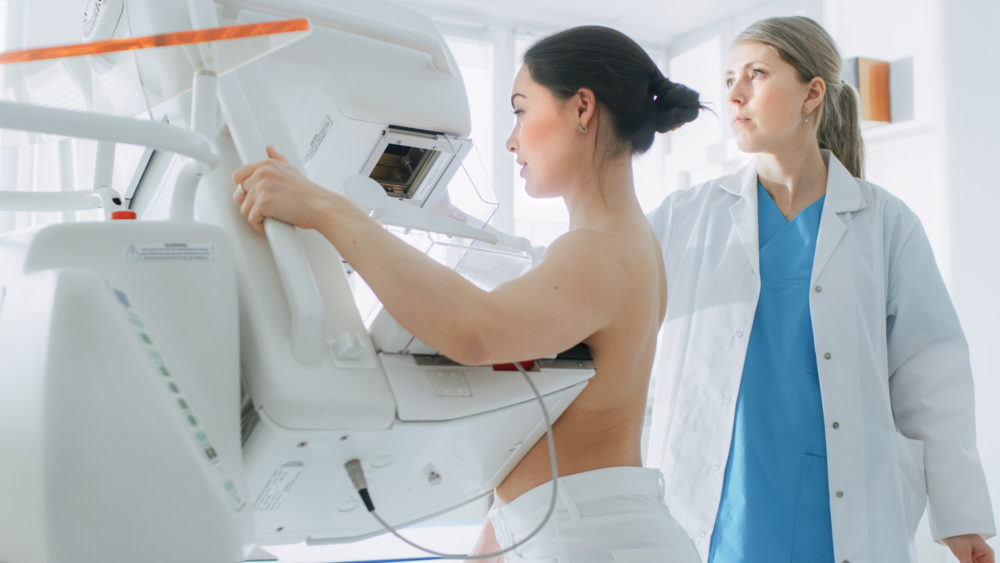
What Is Tomosynthesis (3D mammography)?
Tomosynthesis or “3D” mammography is a new type of digital x-ray mammogram which creates 2D and 3D-like pictures of the breasts
This tool improves the ability of mammography to detect early breast cancers, and decreases the number of women “called back” for additional tests for findings that are not cancers.
During a “3D” exam, an X-ray arm sweeps in a slight arc over your breast, taking multiple low dose x-ray images. Then, a computer produces synthetic 2D and “3D” images of your breast tissue.
The images include thin one millimeter slices, enabling the radiologist to scroll through images of the entire breast like flipping through pages of a book, and providing more detail than previously possible.
The “3D” images reduce the overlap of breast tissue, and make it possible for a radiologist to better see through your breast tissue on the mammogram.
Why is there a need for tomosynthesis breast exams? What are the benefits?
With conventional digital mammography, the radiologist is viewing the tissues of your breast overlapping on flat images.
This tissue overlap can sometimes make cancers hard to detect.
Also, overlap can sometimes create areas that appear abnormal, but require that you be “called back” for additional tests to determine that cancer is not present (so-called false positives).
Tomosynthesis or “3D” mammography directly addresses the current limitations of standard 2D mammography
Multiple studies have shown that “3D” mammography increases the detection of breast cancer by approximately 25%, and decreases the number of false positive call backs by approximately 15%.
What is the difference between a screening and diagnostic mammogram?
A screening mammogram is done in women who have no breast signs symptoms.
A diagnostic mammogram is done in women who have been “called back” from a screening mammogram, or who have a clinical breast symptom such as a lump.
What should I expect during the 3D mammography exam?
Having a “3D” mammogram is similar to a having conventional digital mammogram, including the amount of compression of the breasts and the time in compression.
The main difference is that the X-ray arm sweeps in a slight arc over your breasts.
Why is compression important in mammography?
- Decreases radiation dose
- Separates glandular tissue
- Decreases superimposition of tissue
- Improves resolution or clarity of the image
- Increases contrast to visualize subtle differences in tissue
- Reduces scatter radiation
Who can have a 3D mammography exam?
It is approved for all women who would be undergoing a standard mammogram, in both the screening and diagnostic settings.
References
1 Bernardi D, Ciatto S, Pellegrini M, et. al. Prospective study of breast tomosynthesis as a triage to assessment in screening. Breast Cancer Res Treat. 2012 Jan 22 [Epub ahead of print].
2 The Hologic Selenia Dimensions clinical studies presented to the FDA as part of Hologic’s PMA submission that compared Hologic’s Selenia Dimensions combo-mode to Hologic 2D FFDM.
3 Skaane P, Gullien R, Eben EB, et. al. Reading time of FFDM and tomosynthesis in a population-based screening Program. Radiological Society of North America annual meeting. Chicago, Il, 2011
Read Also
Emergency Live Even More…Live: Download The New Free App Of Your Newspaper For IOS And Android
MRI, Magnetic Resonance Imaging Of The Heart: What Is It And Why Is It Important?
Mammary MRI: What It Is And When It Is Done
Breast Cancer Diagnosis: The Importance Of Periodic Mammography
Mammography: How To Do It And When To Do It
Pap Test: What Is It And When To Do It?
Breast Cancer: For Every Woman And Every Age, The Right Prevention
Transvaginal Ultrasound: How It Works And Why It Is Important
Mammography With Tomosynthesis: What It Is And What Advantages It Offers
Pap Test, Or Pap Smear: What It Is And When To Do It
Mammography: A “Life-Saving” Examination: What Is It?
Breast Cancer: Oncoplasty And New Surgical Techniques
Gynaecological Cancers: What To Know To Prevent Them
Ovarian Cancer: Symptoms, Causes And Treatment
What Is Digital Mammography And What Advantages It Has
What Are The Risk Factors For Breast Cancer?
Breast Cancer Women ‘Not Offered Fertility Advice’
Ethiopia, The Minister Of Health Lia Taddesse: Six Centers Against Breast Cancer
Breast Self-Exam: How, When And Why
Fusion Prostate Biopsy: How The Examination Is Performed
CT (Computed Axial Tomography): What It Is Used For
What Is An ECG And When To Do An Electrocardiogram
MRI, Magnetic Resonance Imaging Of The Heart: What Is It And Why Is It Important?
Mammary MRI: What It Is And When It Is Done
What Is Needle Aspiration (Or Needle Biopsy Or Biopsy)?
Positron Emission Tomography (PET): What It Is, How It Works And What It Is Used For
CT, MRI And PET Scans: What Are They For?
MRI, Magnetic Resonance Imaging Of The Heart: What Is It And Why Is It Important?
Urethrocistoscopy: What It Is And How Transurethral Cystoscopy Is Performed
What Is Echocolordoppler Of The Supra-Aortic Trunks (Carotids)?
Surgery: Neuronavigation And Monitoring Of Brain Function
Robotic Surgery: Benefits And Risks
Refractive Surgery: What Is It For, How Is It Performed And What To Do?
Single Photon Emission Computed Tomography (SPECT): What It Is And When To Perform It
What Is An ECG And When To Do An Electrocardiogram


